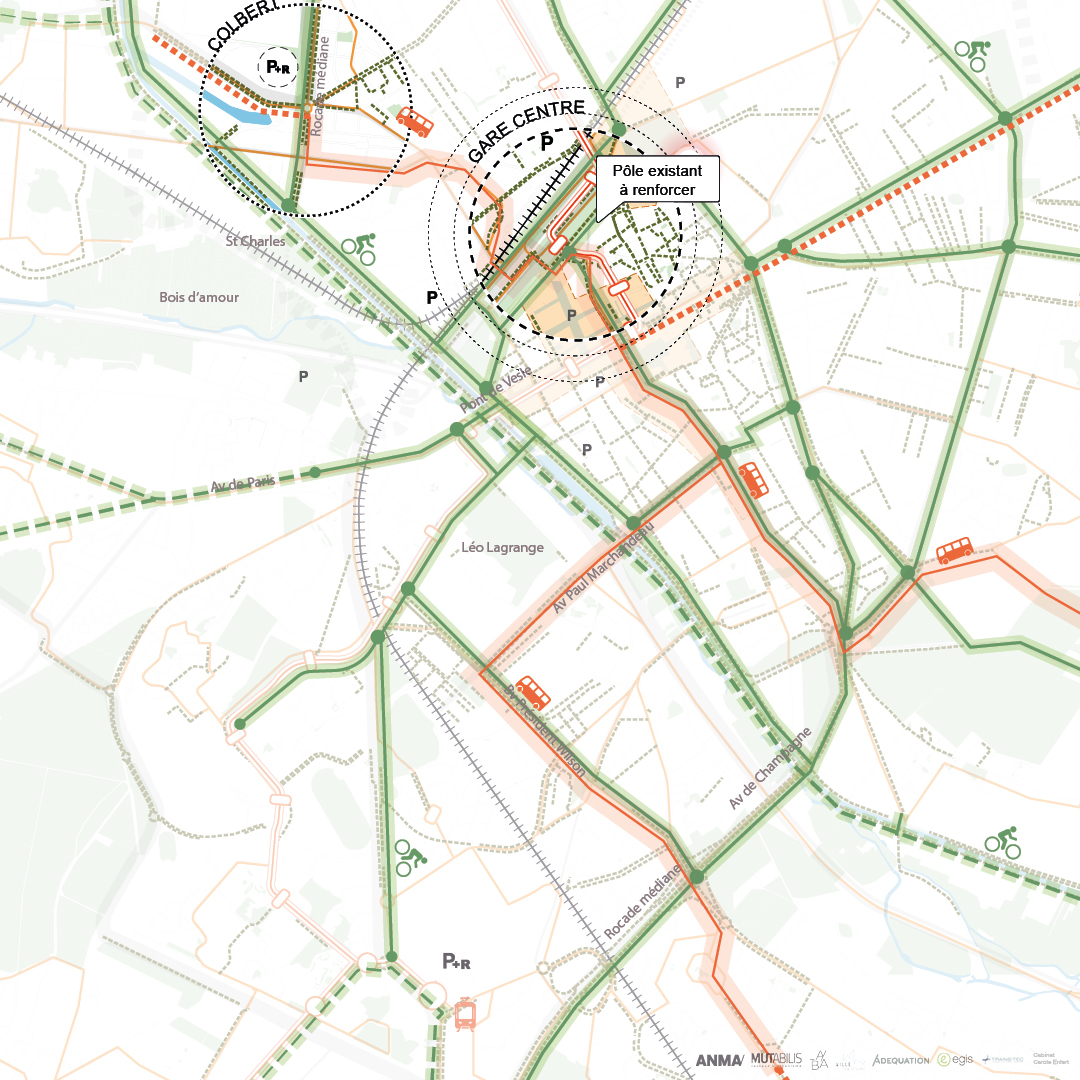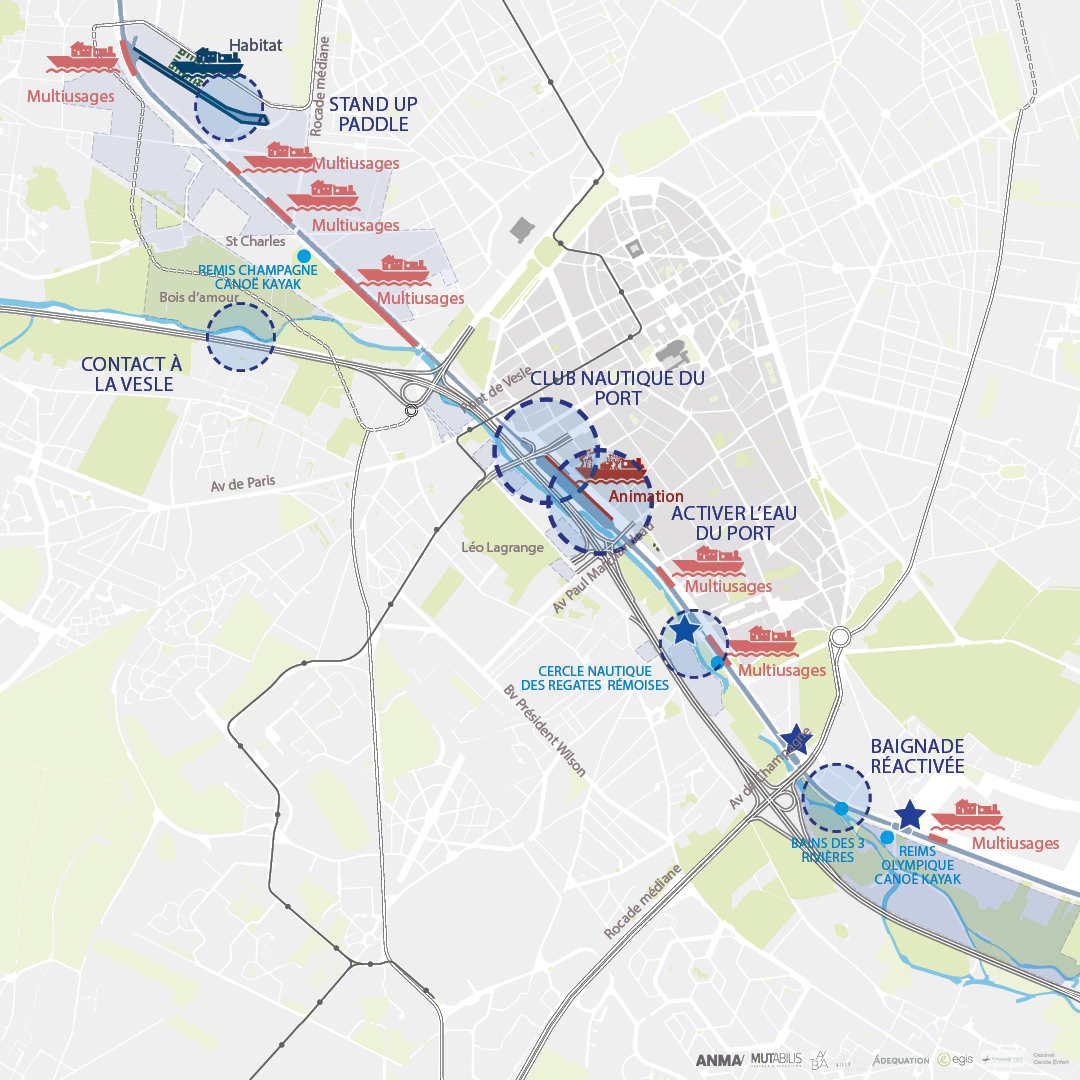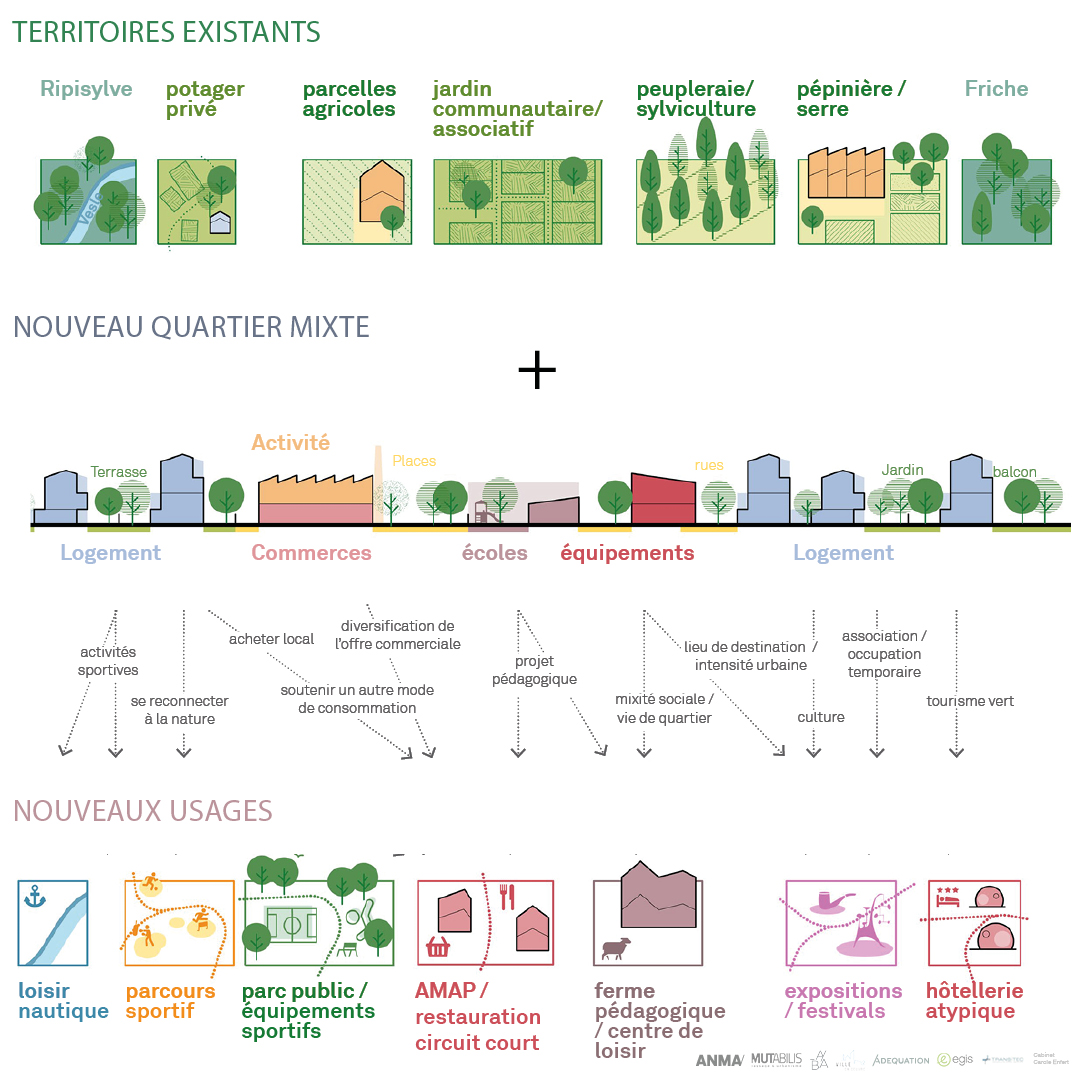
turn the city
towards its canal
The Berges du Canal project in Reims is a challenge for an urban transformation that will allow the city to return to the water: to its canal and its river, the Vesle.
On this 300-hectare site, covering the banks of the two waterways from the Pointe de la Darse to the Parc de la Cerisaie, the aim is clear: not a rigid master plan, but a series of actions and a multi-dimensional approach, in the form of a strategic guide plan, to transform the city and create a new green backbone – the Berges du Canal.
This new urban framework is evolving: it is composed with the existing and the current input data – heritage, ways of living and working – and is so flexible that it defines urban orientations while keeping the possibility of integrating the unknown, the surprise.
In order to do this, based on the historical, cultural, geographical, ecological, political and social context, our team has imagined the simplest and most effective project to give back to the people of Reims a whole part of their city, so close to the historical center and yet so disparately valued.

4 complementary sectors
Our diagnosis, carried out by crossing the expertise of the members of the group, allowed us to identify 4 large sectors, with complementary potentialities and evocative names. Their ambiances follow one another from north to south and set the scene for the 7km route along the canal, highlighting the reality of existing or future uses and the contexts of each of them.
The northernmost, stretching from the quays of Port Colbert to the gates of Parc Saint-Charles, the Canal Habité represents a future new district for Reims, allowing the city of tomorrow to be invented. Today occupied by industrial wasteland, it is notably based on the economic development generated by the arrival of the Neoma business school and the ESAD art school.
It is the sector with the highest potential for urban development in terms of housing, shops, equipment and tertiary activities. While developing along the lines of the already artificialized land, according to the ZAN objective, it is also the bearer of ideas of doing the city differently, of imagining another way of living, contrasting with the historic and more classic city center of Reims.

a new address
metropolitan
Located in the heart of the city, at the crossroads of existing urban fabrics including the historic city center, the banks of the Vesles river, the Léo Lagrange park and the stadium, the Porte Nautique Métropolitaine is a new sector with the potential to become a metropolitan-scale destination, thanks to new facilities, activities and a wide-ranging redevelopment of public spaces. It plays a key role in calming the city by diversifying uses, towards a public space shared by pedestrians and soft mobility, in the continuity of the Jacqueline Osty promenades and in connection with the stadium’s urban connection.
Then, from the Naussonces wasteland to the shared gardens of the Roseraie park, the Canal Sportif is a district that allows for the development of sports-related potentialities. The idea is to build on what is already there, to amplify and enhance the existing activities such as kayaking and rowing of the Cercle Nautique des Régates Rémoises. By giving them a new life and reactivating them, existing and neglected infrastructures, such as the 3 Rivers Bath or the canal locks, can also become a support for activation of the banks by water sports.

6 areas ofdevelopment
Finally, to the south, the Environmental Laboratory, which extends from the Bain des 3 Rivières to the Parc de la Cerisaie, is an area dedicated to the most advanced environmental experiments. We wish to preserve and amplify the existing green webs, to continue to be able to walk between shared gardens, market gardens and parks, but also to welcome the most ambitious projects in ecological and social terms, such as environmental nuggets scattered on the ecology playground.
From one to the other of these sectors, varying in intensity and orienting the cursors according to the urban profile of each space, 6 development axes have been identified.
Improve access and mobility: and imagine a system that is more rewarding than a series of engineering structures overhanging and crossing the canal and the Vesle without ever getting there. Develop soft mobility in a partnership-based approach, effective both in terms of the quality of the facilities and the speed of their implementation, based on and in line with the city’s existing project, Reims à Vélo, enabling the city to be re-connected by soft mobility and crossing the city on both sides in 20 minutes.

a succession of atmospheres
urban
Create synergies of use with the territory: by creating federating public spaces that can be appropriated by the users specific to each sector and the users of future urban projects.
Activate the water: put this resource back at the heart of everyone’s activities and showcase a natural environment that supports a wide range of programming, from cultural activities – boats, cafés, theaters, restaurants – to residential needs – houseboats – and sporting activities – kayaking, swimming poles, paddleboats, rental boats and perhaps river surfing in the future?
Animate the surroundings of the Grand Parc : this new Grand Parc, made up of a succession of different urban atmospheres, can be activated thanks to the development of DRC activities that will transform it into a real destination.

start-ups
operational
Improve the facilities of the Grand Parc : make the quality and practicability of all the facilities of the Grand Parc consistent in order to give it its own identity and facilitate its use. Focus on a distribution of fun activities to animate the different sectors.
Bringing urbanity : accompanying the development of public spaces and mobility by a coherent redevelopment of the wasteland towards new urbanized areas in conjunction with the birth of Reims Grand Parc.
In 2022, our group and the City, within the framework of this major strategic plan, will begin to implement these new ambitions for Reims through several operational sectors: the Port du Centre and its public spaces (11ha), the transformation of the VMC industrial wasteland (13ha), the large Mont Hermé park (16ha), the natural setting of the Bois d’Amour (35ha) and the Port Colbert and its general stores (60ha).

PROJECT TEAM
PROJECT MANAGEMENT
Architecte urbaniste mandataire : ANMA
Paysagiste : Mutabilis
Mobilité : Transitec
Architecture de la mobilité : La/Ba
Urban programming : Adéquation
VRD, ingénierie, environnement : Egis
Operational strategy: Ville en œuvre
Lighting design: Les Éclaireurs
Fontainerie: Llorc
CSPS: Présents
Urban safety, risk prevention: Cronos
STUDIES AND OPERATIONAL MONITORING
Ksénia Tolkacheva
Axel Chifflet
TECHNICAL SHEET
STATUS Pre-operational studies
PROJECT MANAGEMENT City of Reims
SCHEDULE 2021-2025
AREA Reflection area 260 ha, operational sectors 162 ha, thematic focus 26 ha
ICONOGRAPHY ANMA Architectes Urbanistes
SEE +
Bordeaux, Bassins à flot
La Défense, Boulevard Circulaire
Tournai, Quai des Salines
